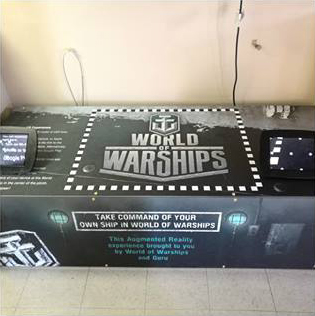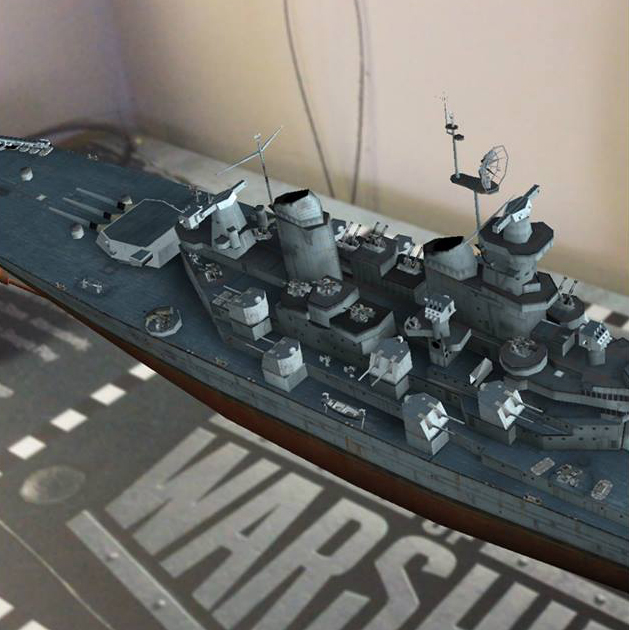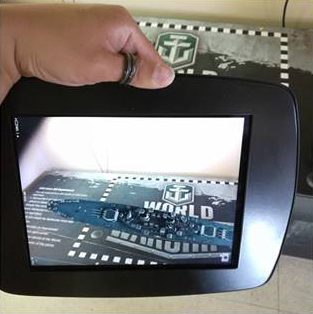“We know from surveys that they like to visit military history museums or watch documentaries about WWII,” Spaight said. “Other players may appreciate our attention to historical detail, but they are more excited about the fast-paced combat or short-session battles. Sometimes players come for the game, but then get interested in the history. And that’s great.
Aboard the Iowa
Wargaming is investing in WWII history. The company just completed an augmented reality (AR) installation on the USS Iowa, the battleship that was part of the Pacific Fleet during the Second World War. It’s now docked in Los Angeles, and serves as a museum run by the Pacific Battleship Center.
The first stop on the official museum tour features a six-foot-long World of Warships plinth. Pointing the attached iPad at the trigger image spawns a matching USS Iowa, pulled from the video game, as it looked during WWII, before its current postwar modifications. It’s also accessible through the official USS Iowa tour app (Android | iOS) that the ship launched with tech company Guru. This is actually one of two Wargaming exhibits on the Iowa.
“The leadership team at Pacific Battleship Center is keen on exploring innovative ways to use technology to tell stories about the battleship,” Spaight said. “We have worked with them on a number of projects, including creating a computer-generated film for their digital theater about the Battle of Okinawa. We hope to work with them again in the future on new interactive experiences.”
Bombers and cruisers
The USS Iowa is Wargaming’s fourth AR initiative in partnership with museums around the world. The game publisher created its first mobile AR experience in 2013 in partnership with the Royal Airforce Museum and a company called Red Loop. The museum had just recovered the only known Dornier 17 bomber, which had been shot down off the coast of Kent during the battle of Britain. Wargaming sponsored the exhibition and created the Wargaming.net Interpretation Zone.
“Londoners were surprised to see a WW1 tank driving down the street.”
“We helped develop a mobile App called Apparitions,” Spaight said. “Using the mobile app, users could see the historic plane as it appeared in 1940 both at the museum and at geo-fenced locations around the world. In effect, we brought the museum out into the world, so that everyone could see the Dornier.”
In May of this year, Wargaming worked with the National Museum of the Royal Navy in Portsmouth, UK to commemorate the 100th anniversary of the Battle of Jutland. One of the challenges the museum faced is that the Jutland exhibit would open in Portsmouth, but HMS Caroline – the only surviving ship from the battle – is permanently anchored in Belfast, Northern Ireland.
“What we proposed was to bring the ship to the museum virtually, so she could be part of the exhibition,” Spaight said. “Museum goers are now able to see the ship on an eight-foot-long plinth we constructed, by downloading the HMS Caroline App (developed with our partner Ballista Digital) and pointing their smartphone or tablet at the trigger image on the table. The mobile app tells the story of the ship and the Battle of Jutland.”
Tanks in the street
This September, Wargaming worked with The Tank Museum in Bovington, England to mark the 100th anniversary of the first battlefield use of the tank. The company held an event in Trafalgar Square with a replica Mark IV tank from the Steven Spielberg movie Warhorse.
“Londoners were surprised to see a WW1 tank driving down the street,” Spaight said. “We worked with Ballista Digital to create a mobile app called Tank 100. Users can use the ‘tank hunter’ feature to see Mark 1 tanks (in AR) in town squares across the UK – or they can simply spawn a Mark I at their location.”
A new type of vision
The quick iterations of technology packed inside today’s smartphones and tablets is opening up new opportunities for Wargaming to bring history alive.
“The additional processing power allows us to use higher poly models and richer texture maps in the mobile apps we develop,” Spaight said. “AR engines are getting better at holding a model in space, even if the user is moving the tablet or smartphone around and the trigger images falls out of frame. It’s a much more user-friendly experience than before.”
“We want to keep pushing the envelope with AR technology.”
Spaight said the introduction of new, more powerful headsets like Meta 2, CastAR and Hololens will also expand the possibilities for museums and at-home AR experiences.
“Google’s Tango uses computer vision to give devices the ability to understand their position relative to the world around them,” Spaight said. “This platform enables developers to create 3D objects like a tank that will understand where the edge of the table is – or to be occluded by a real world vase if the user moves it behind it. We’re exploring how we might use this functionality in museum settings.”
Microsoft showcased Minecraft on HoloLens at E3 2015, and that AR headset is already available for developers and businesses. In the future, it will enter living rooms around the world.
“We want to keep pushing the envelope with AR technology,” Spaight shares. “If we’ll soon be playing Minecraft with an AR visor on the floor and furniture of our living rooms, then we should be able to recreate a naval battle with dozens of warships on the floor of a museum.”






